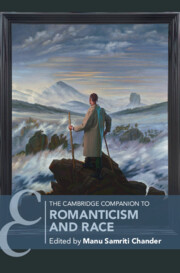Book contents
- The Cambridge Companion to Romanticism and Race
- The Cambridge Companion to Romanticism and Race
- Copyright page
- Contents
- Figures
- Contributors
- Acknowledgments
- Introduction
- Chapter 1 Burke and Kant on Color and Inheritance
- Chapter 2 Breathing Freedom in the Era of the Haitian Revolution
- Chapter 3 Afropessimism, Queer Negativity, and the Limits of Romanticism
- Chapter 4 Samuel Taylor Coleridge’s Racial Imaginary
- Chapter 5 (Not)freedom
- Chapter 6 Disability and Race
- Chapter 7 The Crip Foundations of Romantic Medicine
- Chapter 8 The Voice of Complaint
- Chapter 9 Romantic Manscapes
- Chapter 10 Romantic Poetry and Constructions of Indigeneity
- Chapter 11 Romanticism and the Novel(ty) of Race
- Chapter 12 Reading Race Along the “Bounding Line”
- Chapter 13 The Racecraft of Romantic Stagecraft
- Further Reading
- Index
- Cambridge Companions To Literature
Chapter 3 - Afropessimism, Queer Negativity, and the Limits of Romanticism
Published online by Cambridge University Press: 21 November 2024
- The Cambridge Companion to Romanticism and Race
- The Cambridge Companion to Romanticism and Race
- Copyright page
- Contents
- Figures
- Contributors
- Acknowledgments
- Introduction
- Chapter 1 Burke and Kant on Color and Inheritance
- Chapter 2 Breathing Freedom in the Era of the Haitian Revolution
- Chapter 3 Afropessimism, Queer Negativity, and the Limits of Romanticism
- Chapter 4 Samuel Taylor Coleridge’s Racial Imaginary
- Chapter 5 (Not)freedom
- Chapter 6 Disability and Race
- Chapter 7 The Crip Foundations of Romantic Medicine
- Chapter 8 The Voice of Complaint
- Chapter 9 Romantic Manscapes
- Chapter 10 Romantic Poetry and Constructions of Indigeneity
- Chapter 11 Romanticism and the Novel(ty) of Race
- Chapter 12 Reading Race Along the “Bounding Line”
- Chapter 13 The Racecraft of Romantic Stagecraft
- Further Reading
- Index
- Cambridge Companions To Literature
Summary
While the Romantic vampire has often been read as disrupting heteropatriarchal norms, in reading Uriah Derick D’Arcy’s The Black Vampyre, Deanna Koretsky exposes how the supposedly liberatory figure of the vampire upholds the antiblackness at the heart of the Gothic tradition. Koretsky sharply and counterintuitively argues that there is in fact nothing more representative of the human than the figure of the vampire and that D’arcy’s black vampire thus threatens the modern sociopolitical order built on expelling blackness from the category of the human.
- Type
- Chapter
- Information
- The Cambridge Companion to Romanticism and Race , pp. 37 - 55Publisher: Cambridge University PressPrint publication year: 2024

